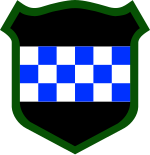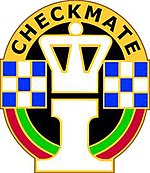| 99th Infantry | |
|---|---|
 99th Infantry Division shoulder sleeve insignia | |
| Active | 1918 - 1919 1921 - 1945 |
| Country | |
| Branch | |
| Type | Infantry |
| Size | Division |
| Nickname(s) | "Battle Babies" "Checkerboard Division" |
| Engagements | World War II |
| Commanders | |
| Notable commanders | Walter E. Lauer |
| Insignia | |
| Distinctive unit insignia |  |
The 99th Infantry Division briefly existed, but never deployed, in the closing days of World War I, was reconstituted as a reserve unit in 1921, was ordered into active military service in 1942, and deployed overseas in 1944. The 99th landed at the French port of Le Havre and proceeded northeast to Belgium. During the heavy fighting in the Battle of the Bulge, the unit suffered many casualties, yet tenaciously held its defensive position. In March 1945, the 99th advanced into the Rhineland, crossing the Rhine River at Remagen on March 11. After fighting in the Ruhr area, the unit moved southward into Bavaria, where it was located at the end of the war.
The 99th Infantry Division gained the nickname the "Checkerboard" division, from its unit insignia that was devised in 1923 while it was headquartered in the city of Pittsburgh. The blue and white checkerboard in the insignia is taken from the coat of arms of William Pitt, for whom Pittsburgh is named. The division was also known as the "Battle Babies" during 1945, a sobriquet coined by a United Press correspondent when the division was first mentioned in press reports during the Battle of the Bulge.[1]
On May 3–4, 1945, as the 99th moved deeper into Bavaria, it liberated one of a number of Dachau subcamps near the town of Mühldorf. The unit reported on May 4 that it had "liberated 3 labor camps and 1 concentration camp." The concentration camp was one of the "forest camps" (Waldlager) tied to the Mühldorf camp complex. The 99th Infantry's report stated that 1,500 Jews were "living under terrible conditions and approximately 600 required hospitalization due to starvation and disease."
The 99th Infantry Division was recognized as a liberating unit by the US Army's Center of Military History and the United States Holocaust Memorial Museum in 1992.
The insignia, though not the US Army recognized lineage, is maintained by the 99th Readiness Division, a United States Army Reserve (USAR) unit constituted in 1967, serving as of 2023 as a geographic command, headquartered at Joint Base McGuire–Dix–Lakehurst in New Jersey.